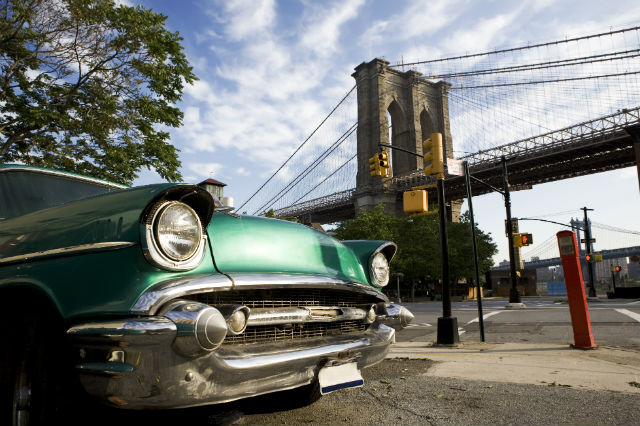It’s exciting to buy a brand-new car, but there’s something special about purchasing an antique or collectible and then restoring it to its former glory. These cars might not have perfect paint or perfect engines, but each has a unique personality waiting to be uncovered. All you need is time and patience and you can give an old car new life. Where to start? Here are a few tips to guide you through your antique car restoration.
Find the Right Car
The first step is finding the right car. It’s not like going down to the local dealership and buying a new car off the lot. Instead, you’re going to need to do some research to find one that fits your needs and your budget.
As you narrow down your search, reach out to like-minded folks in your community or online who have experience with the type of car you want to buy. “Visit car shows and clubs and ask owners of similar vehicles about what they have found, tips, tricks, and pitfalls,” said John Paul, AAA’s Car Doctor.
There’s nothing wrong with asking an experienced restorer for help and advice about which car to pick. Not only can they guide you in choosing the right car, they can help steer you away from taking on a project that may be more than you can handle.
Watch for Rust
It’s just a tiny bit of rust, so it’s no big deal, right? Wrong. Even a small amount of rust can end up being an expensive and timely repair. A visual inspection might turn up only some of the damage. Not until you take the car apart will the full extent of the damage be revealed.
Make sure you’re comfortable doing bodywork if you’re purchasing a car in need of rust repairs. The process requires skill and isn’t something you can wing if you want the finished product to look right. If the idea of sand blasting metal and possibly fabricating replacement panels from sheet metal isn’t in your skill set or something you want to learn, then avoid a car with rust.
Decide on the Type of Restoration You Want
It’s not simply a matter of making a car run again or even about making it look like new. There are a variety of ways you can go about a restoration depending on what you want for the finished product. A less expensive option is to restore it as a daily driver that might not be perfectly period-accurate, but still looks great and runs.
If you have more time and are prepared to spend more money, then you can go with a concours restoration. This gives you a period-accurate vehicle that looks and runs as it did when it was new, but the attention to detail required for this type of restoration isn’t for everyone.
You can also go with a resto-mod, which creates a one-of-a-kind car that is uniquely you. These look like classic cars on the outside, but beneath the surface hide all sorts of modern components from engines to drivetrains to brakes. The nice part about a resto-mod is that you create exactly the car you want and can more easily change the plan to suit your needs as the restoration progresses.

Check on the Availability of Parts
“Depending on the year, make and model, some parts are available as aftermarket replacement and simplify the repair process, but some require time consuming fabrication, using specialized tools,” says Paul. This is especially true if you’re buying a rare car. If the vehicle isn’t common, then the chance of ready replacement parts is unlikely.
Make sure you check on the availability of replacement parts before you pick your car restoration project and plan accordingly. It will take extra time to find the right parts for a rare car and the cost of those parts will be more expensive.
Be cautious of the quality of parts and “great deals” on internet sites. There is quite a difference in quality and function of parts sourced from across the globe. Avoid buying the absolute lowest-priced version of part, at least look in the mid-grade area if not top-quality tiers.
Make a Plan
Restoring a car isn’t something that happens over a matter of days or even months. It can take years to complete a car restoration and it helps to plan out how you want to do it and how long you expect it to take.
This will help you stay on track and make consistent progress. Rather than getting sidelined trying to do everything at once, a plan lets you focus on one thing at a time. It also helps keep you motivated. If there’s a lot of work to be done, finishing one small item on your to-do list provides a sense of accomplishment and keeps you motivated.
Be Prepared to Change That Plan
As much as you need a plan, but you also need to be prepared to change that plan. Charles Strickler, author of the mystery-thriller “Restorations,” came to the car restoration world through his son. Their experiences led to Strickler writing a novel with a car as something of a central character.
He has fond memories of working with his son and knows firsthand that you need to be ready for surprises. “When you are working on one of these projects, they almost never go as planned. You have to accept that sometimes you have to take two steps backwards to move ahead. Be patient and give it your best. In the end you will find unexpected rewards,” said Strickler.
Also, don’t be afraid to seek professional help when you feel like you have bitten off more than you can chew on a certain aspect of the restoration. It’s more cost effective and timely to pay a pro to do something once than having to undo and redo something that was done incorrectly.
Do It for Love, Not money
It takes time, money, and patience to restore a car. Whether you have years of experience or are attempting a restoration for the first time, it’s a serious commitment and one that isn’t likely to make money.
Most people end up spending more to restore their vehicle than the finished car is worth. Sure, there are those who are in the business of restoring cars for a profit, but there’s a difference between a business and a hobby. Don’t look at it as an investment. “Repair the car for the fun of it, the love of it but not hoping to make a profit,” says Paul. Take time to enjoy the process as you step into the world of car restoration.
Have you restored a classic car? What advice do you have? Share them with us in the comments below.
Did you know that AAA offers collector car insurance? Click here to learn how to protect your prized possession.
2 Thoughts on “7 Tips for Antique Car Restoration”
Leave A Comment
Comments are subject to moderation and may or may not be published at the editor’s discretion. Only comments that are relevant to the article and add value to the Your AAA community will be considered. Comments may be edited for clarity and length.
















I’ve Make A Living Restoring Vehicles N Customizing them
thanks for the info on lemon law… might havew to check this out thanks mr